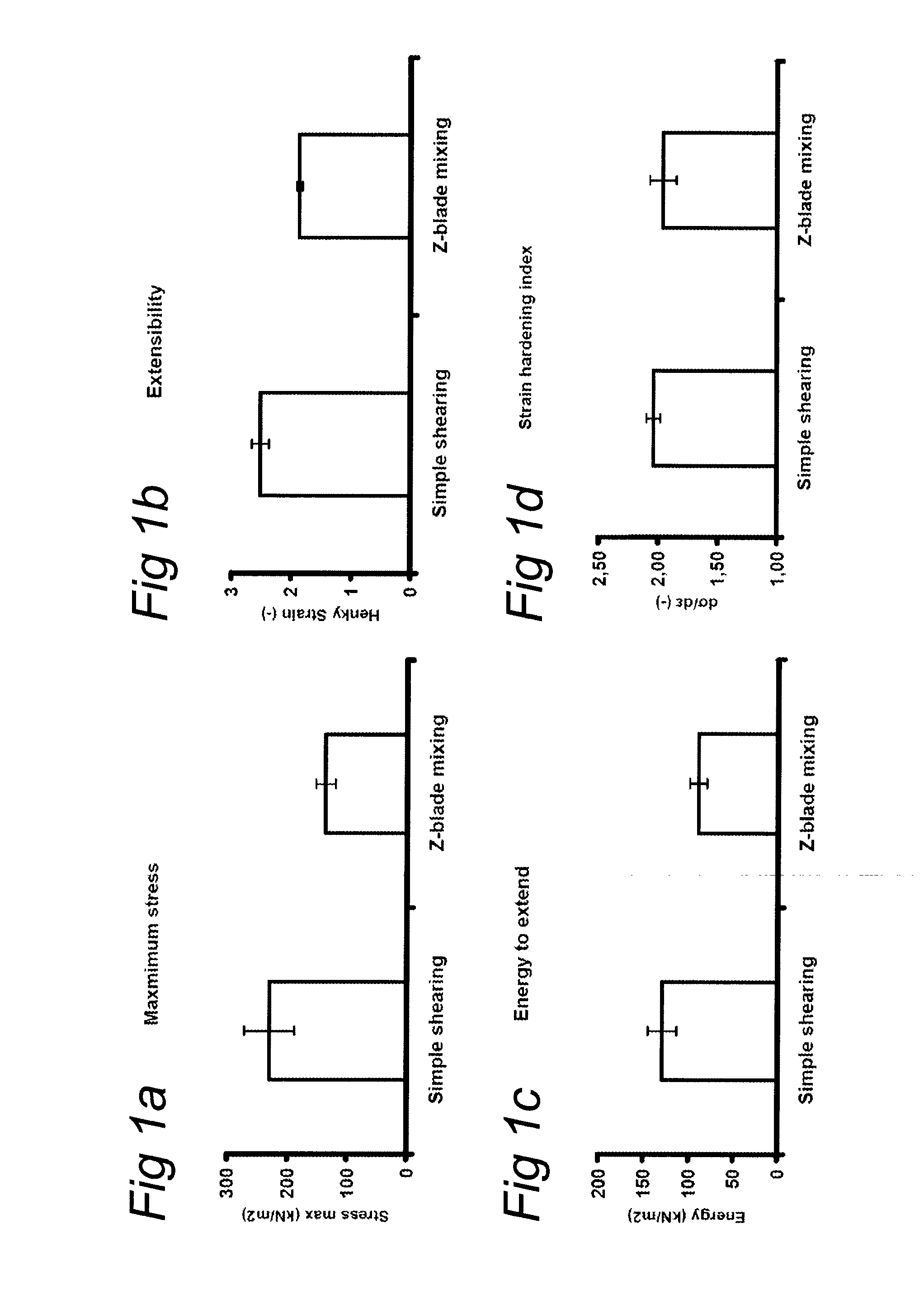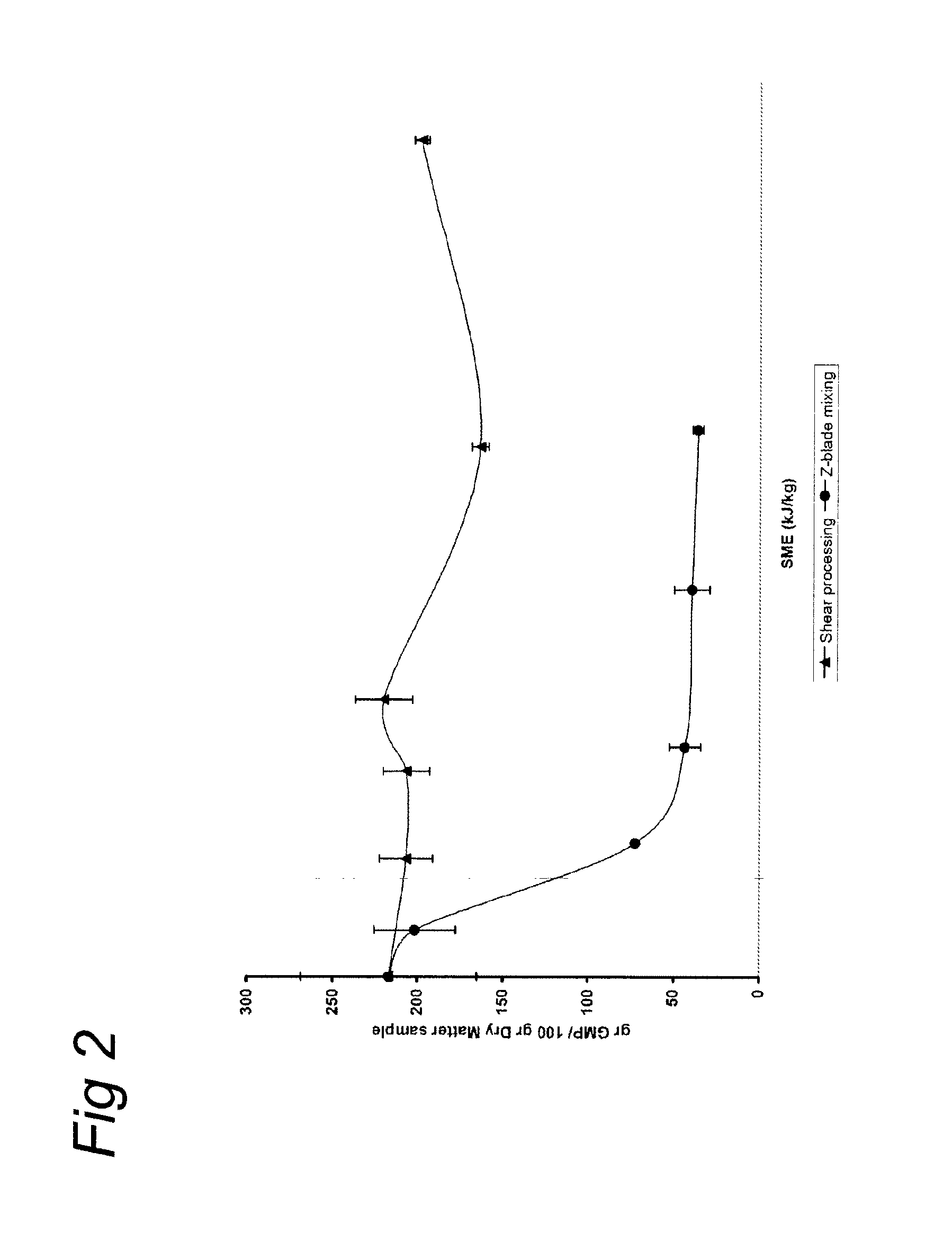Process for the separation of gluten and starch
a technology which is applied in the field of process for the separation of gluten and starch, can solve the problems of large amount of water used, easy damage to gluten, and loss of function, and achieve the effects of reducing the loss of soluble proteins, and increasing protein yield
- Summary
- Abstract
- Description
- Claims
- Application Information
AI Technical Summary
Benefits of technology
Problems solved by technology
Method used
Image
Examples
example 1
1.1. Materials
[0052]Spring and Soissons flour samples were supplied by WCFS, Wageningen, the Netherlands. Spring is a strong and hard Canadian and Soissons is a weak French wheat cultivars. According to the supplier both flours are pure and obtained from single wheat cultivars. A gluten-starch (GS) mixture with 11% gluten (db) was selected as a weak raw material source. Commercial wheat gluten and starch were obtained from Roquette Co. (France). Sodium dodecyl sulphate (SDS) was obtained from Sigma having a purity higher than 99%. All other chemicals and staining agents used were at least of analytical grade.
1.2. Analytical Methods
[0053]Moisture and ash content and the Farinograph characteristics of raw materials were determined following the AACC Approved Methods 44-15A, 08-01 and 54-21, respectively (AACC, 2000; Approved Methods of the AACC 10th Ed. American Association of Cerial Chemists, St. Paul, Minn.). The protein contents (N×5.7) of flour and freeze-dried GMP samples were de...
example 2
2.1. Isolation of GMP from Flour
[0058]A flour sample (5 g) was dispersed in 75 mL petroleum ether, mixed for 15 min and centrifuged (10000 rpm, 10 min at ambient temperature). Petroleum ether residues in the defatted flour sample were evaporated by keeping the flour overnight in a fume hood at ambient temperature.
[0059]The following method was used for the isolation of GMP from flour. The defatted sample was weighed (1.55 g) in an ultra-centrifuge tube of approximately 33 mL. The tube was then placed on a Vortex mixer. While rigorous vortexing, 9.125 mL deminerlized water (demi water) was added with a calibrated dispenser. Vortexing was continued for about 10 to 15 seconds till a homogenous and lump-free suspension was obtained. Immediately after suspending, 3.875 mL 12% (w / v) SDS solution was added, followed by addition of two portions of 9 mL demi water with a dispenser to reach a final concentration of 1.5% (w / v) SDS. The tubes were then ultra-centrifuged (80000 g, 30 min at 20° ...
example 3
3.1 Sampling of Dough for Extension Testing
[0061]Two samples were taken from the sheared dough: one, taken parallel to the shear direction, was designated “P” and the other, taken perpendicular (transverse) to the shear direction, was encoded as “T”. A piece of dough, approximately 7×4 cm, suitable for studying in the SMS / Kieffer Dough and Gluten Extensibility Rig (Stable Micro Systems, Godalming, Surrey, UK) was cut using a razor blade. The dough sample was placed immediately in a pre-warmed (30° C.) Petri dish. To prevent any moisture loss, the dough was covered by a glass cap and placed in a humid atmosphere (RH=85%) where it was kept at 26° C. for 45 min. This period allowed handling and transporting of dough specimens for extension testing.
[0062]After mixing, a piece of dough (approximately 20 g) was rounded gently into a small ball and kept as described for the sheared samples. The sampling of the dough for both the shear and mixing processes was carried out with as little man...
PUM
| Property | Measurement | Unit |
|---|---|---|
| shear stress | aaaaa | aaaaa |
| temperature | aaaaa | aaaaa |
| temperature | aaaaa | aaaaa |
Abstract
Description
Claims
Application Information
 Login to View More
Login to View More - R&D
- Intellectual Property
- Life Sciences
- Materials
- Tech Scout
- Unparalleled Data Quality
- Higher Quality Content
- 60% Fewer Hallucinations
Browse by: Latest US Patents, China's latest patents, Technical Efficacy Thesaurus, Application Domain, Technology Topic, Popular Technical Reports.
© 2025 PatSnap. All rights reserved.Legal|Privacy policy|Modern Slavery Act Transparency Statement|Sitemap|About US| Contact US: help@patsnap.com



